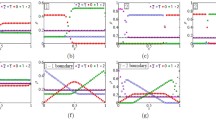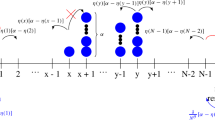Abstract
We study a multispecies generalization of a left-permeable asymmetric exclusion process (LPASEP) in one dimension with open boundaries. We determine all phases in the phase diagram using an exact projection to the LPASEP solved by us in a previous work. In most phases, we observe the phenomenon of dynamical expulsion of one or more species. We explain the density profiles in each phase using interacting shocks. This explanation is corroborated by simulations.








Similar content being viewed by others
References
Derrida, B., Evans, M.R., Hakim, V., Pasquier, V.: Exact solution of a 1d asymmetric exclusion model using a matrix formulation. J. Phys. A 26(7), 1493 (1993)
Blythe, R.A., Evans, M.R.: Nonequilibrium steady states of matrix-product form: a solver’s guide. J. Phys. A 40(46), R333 (2007)
Schadschneider, A.: Traffic flow: a statistical physics point of view. Phys. A 313(1), 153–187 (2002). (Fundamental Problems in Statistical Physics)
Chowdhury, D., Santen, L., Schadschneider, A.: Statistical physics of vehicular traffic and some related systems. Phys. Rep. 329(4), 199–329 (2000)
Penington, C.J., Hughes, B.D., Landman, K.A.: Building macroscale models from microscale probabilistic models: a general probabilistic approach for nonlinear diffusion and multispecies phenomena. Phys. Rev. E 84, 041120 (2011)
Evans, M.R., Foster, D.P., Godrèche, C., Mukamel, D.: Asymmetric exclusion model with two species: spontaneous symmetry breaking. J. Stat. Phys. 80(1), 69–102 (1995)
Arita, C.: Phase transitions in the two-species totally asymmetric exclusion process with open boundaries. J. Stat. Mech. 2006(12), P12008 (2006)
Uchiyama, M.: Two-species asymmetric simple exclusion process with open boundaries. Chaos Solitons Fractals 35(2), 398–407 (2008)
Ayyer, A., Lebowitz, J.L., Speer, E.R.: On the two species asymmetric exclusion process with semi-permeable boundaries. J. Stat. Phys. 135(5), 1009–1037 (2009)
Ayyer, A., Lebowitz, J.L., Speer, Eugene R.: On some classes of open two-species exclusion processes. Markov Process. Relat. Fields 18(5), 157–176 (2012)
Crampe, N., Mallick, K., Ragoucy, E., Vanicat, M.: Open two-species exclusion processes with integrable boundaries. J. Phys. A 48(17), 175002 (2015)
Crampe, N., Evans, M.R., Mallick, K., Ragoucy, E., Vanicat, M.: Matrix product solution to a 2-species TASEP with open integrable boundaries. J. Phys. A 49(47), 475001 (2016)
Ayyer, A., Finn, C., Roy, D.: Matrix product solution of a left-permeable two-species asymmetric exclusion process. Phys. Rev. E 97, 012151 (2018)
Evans, M.R., Ferrari, P.A., Mallick, K.: Matrix representation of the stationary measure for the multispecies TASEP. J. Stat. Phys. 135(2), 217–239 (2009)
Prolhac, S., Evans, M.R., Mallick, K.: The matrix product solution of the multispecies partially asymmetric exclusion process. J. Phys. A 42(16), 165004 (2009)
Ferrari, P.A., Martin, J.B.: Multi-class processes, dual points and M/M/1 queues. Markov Process. Relat. Fields 12(2), 175–201 (2006)
Ferrari, P.A., Martin, J.B.: Stationary distributions of multi-type totally asymmetric exclusion processes. Ann. Probab. 35(3), 807–832, 05 (2007)
Ayyer, A., Linusson, S.: Correlations in the multispecies TASEP and a conjecture by lam. Trans. Am. Math. Soc. 369(2), 1097–1125 (2017)
Cantini, L., Garbali, A., de Gier, J., Wheeler, M.: Koornwinder polynomials and the stationary multi-species asymmetric exclusion process with open boundaries. J. Phys. A 49(44), 444002 (2016)
Ayyer, A., Roy, D.: The exact phase diagram for a class of open multispecies asymmetric exclusion processes. Sci. Rep. 7, 13555 (2017)
Crampe, N., Finn, C., Ragoucy, E., Vanicat, M.: Integrable boundary conditions for multi-species ASEP. J. Phys. A 49(37), 375201 (2016)
Uchiyama, M., Sasamoto, T., Wadati, M.: Asymmetric simple exclusion process with open boundaries and Askey–Wilson polynomials. J. Phys. A 37(18), 4985 (2004)
Acknowledgements
We thank the referees for a number of useful suggestions. The first and third authors are supported by UGC Centre for Advanced Studies (Grant No. F. 510/25/CAS-II/2018(SAP-I)). The first author was also partly supported by Department of Science and Technology Grant EMR/2016/006624.
Author information
Authors and Affiliations
Corresponding author
Appendix A: The Even mLPASEP
Appendix A: The Even mLPASEP
We explain the salient features of the phase diagram of the even mLPASEP focusing on the aspects that make the analysis more complicated than that for the odd mLPASEP.
The computation of the generalized phase diagram for the even mLPASEP requires us to project to the single-species ASEP [22] which we review briefly. The ASEP involves only particles and vacancies, denoted by 1 and \(\overline{1}\) respectively. The boundary transitions, in accord with our definitions in Eq. (5) and (4), have the following rates:

The relevant left and right boundary parameters are \(\lambda = \kappa _{\alpha _{1}, \gamma '_{0}}^{+}\) and \(b = \kappa _{\beta , \delta }^{+}\) respectively, where \(\kappa ^\pm _{u,v}\) is defined in (7). With this notation, the phase diagram formally looks exactly like Fig. 1 with the same nomenclature for the phases: phase \(\overline{\mathbb {1}}\) (MC), 0 (LD) and \(\mathbb {1}\) (HD). The currents and densities of species 1 for all three phases are also identical to those in Table 1. The density profiles for ASEP can also be understood by appealing to shocks. Since this is reviewed by Blythe and Evans in [2], we only illustrate the shock picture for the coexistence line \(b=\lambda >1\) in Fig. 9, where the shock has zero mean velocity. In the LD (resp. HD) phase, the shock has positive (resp. negative) velocity and is pinned to the right (resp. left).
Time-average densities in four species mLPASEP for species \(\overline{2}\) (red circles), \(\overline{1}\) (magenta diamonds), 0 (green boxes), 1 (blue crosses) and 2 (black triangles) for a phase \(\overline{\mathbb {2}}\) (\( \lambda _1 \simeq 0.23 ,\lambda _2 \simeq 0.84, b \simeq 0.65\)), b phase \(\overline{\mathbb {1}}\) (\( \lambda _1 \simeq 0.44, \lambda _2 \simeq 2.65, b \simeq 0.75\)), c phase 0 (\( \lambda _1 \simeq 2.27, \lambda _2 \simeq 6.5, b \simeq 0.92\)), d phase \(\mathbb {1}\) (\( \lambda _1 \simeq 1.17, \lambda _2 \simeq 6.45, b \simeq 3.09\)), e phase \(\mathbb {2}\) (\( \gamma _1 \simeq 0.12 , q=0.41, \beta =0.15,\delta =0.86, \lambda _1 \simeq 1.17, \lambda _2 \simeq 6.45, b \simeq 9.28\)), f 0\(-\mathbb {1}\) co-existence line (\( \lambda _1 = 3, \lambda _2 \simeq 7.18, b = 3 \)), and g\(\mathbb {1}-\mathbb {2}\) co-existence line (\( \lambda _1 \simeq 1.34, \lambda _2 = 6, b = 6\)). For all simulations, we fix the lattice size to be 1000 (Color figure online)
The phase diagrams for the even mLPASEP with 2r species and the odd mLPASEP with \((2r+1)\) species have identical structure as depicted in Fig. 3. The main difference between the two is that the 1-colouring projects the even mLPASEP to the ASEP so that the boundary parameters are \(\lambda _{1}=\kappa ^{+}_{\theta _{1}, \gamma '_{0}}\) and \(b=\kappa ^{+}_{\beta , \delta }\). All other k-colourings continue to project the even mLPASEP to the LPASEP with boundary parameters \(\lambda _{k} = \theta _{k}/\phi '_{k}\) and \(b= \kappa ^{+}_{\beta , \delta }\)., where \(\theta _{k} = \sum _{i=k}^{r} \alpha _{i}\) and \(\phi '_{i} = \sum _{i=1}^{k-1}\left( \alpha _{i} + \alpha _{\overline{i}} \right) \) were defined in Sect. 2.2.
Taking into account all possible colourings, there are \(r+1\) relevant boundary parameters, namely, \(\lambda _{1}, \ldots , \lambda _{r}\) and b. Again, the inequalities \(\lambda _{1}< \lambda _{2}< \cdots < \lambda _{r}\) are satisfied. Because of these relations among \(\lambda _{i}\)’s, we arrive at the same phase diagram in Fig. 3 which shows all \(2r+1\) phases in the even mLPASEP. In all phases except phase 0, the densities of all species have the same expression in the even mLPASEP as given in Table 2. In phase 0, the densities of 1 and \(\overline{1}\) are \((f(\lambda _{1}) - f(\lambda _{2}))\) and \((\overline{f}(\lambda _{1}) - f(\lambda _{2}))\) respectively. We illustrate the density profiles with simulations for the 4-species even mLPASEP in Fig. 10.
The shock picture in the even mLPASEP is identical to that in the odd mLPASEP in all coexistence lines except the 0\(-\mathbb {1}\) boundary.
On this coexistence line, 1’s and \(\overline{1}\)’s form a shock with zero drift as shown in Fig. 11. The shock is pinned to the right (resp. left) boundary in phase 0 (resp. \(\mathbb {1}\)). In phase \(\overline{\mathbb {1}}\), the density of these two species become equal and the height of the shock goes to zero as the system approaches this phase along the 0\(-\mathbb {1}\) coexistence line. We have performed simulations showing instantaneous density profiles for the even mLPASEP with four species on the 0\(-\mathbb {1}\) boundary and the results exactly match with the theoretical prediction.
Rights and permissions
About this article
Cite this article
Ayyer, A., Finn, C. & Roy, D. The Phase Diagram for a Multispecies Left-Permeable Asymmetric Exclusion Process. J Stat Phys 174, 605–621 (2019). https://doi.org/10.1007/s10955-018-2183-x
Received:
Accepted:
Published:
Issue Date:
DOI: https://doi.org/10.1007/s10955-018-2183-x







